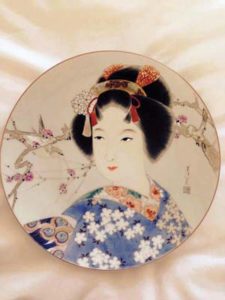
PB’s grandfather, a bigwig with Westinghouse in the 1930’s, went to Japan to explore a joint business with Mitsubishi. The Board of Mitsubishi Goshi presented him with a delicate porcelain plate.
PB believes the porcelain piece, painted with a delicate beautiful face of a geisha, holds value, in the tradition of giving fine expensive gifts for which the Japanese are known. But, PB, Japan in general in the early 1930’s consisted of a tumultuous and depressed economy. An uber-strong military which occupied Chinese Manchuria threatened Japan. As a result Japan withdrew from the League of Nations. Most of the existing Japanese political cabinet was assassinated, and in 1937 Japan mounted a full-scale war against China which lasted until the end of World War II.
When your grandfather visited Mitsubishi in the early 1930’s, international trade was a dream. By 1937 trade became impossible. So I believe in the probability that the porcelain plate was both valuable and culturally relevant.
The material is one of the best – Kutani (the “place of nine valleys”).
Porcelain of the second quarter 20th century traditions in Kutani date from the 17th century kilns. The marks indicate the artisan to have been Tokuda Yasokichi I (1874-1956) a “human cultural asset,” in other words, a national treasure. Today Tokuda Yasokichi III continues the tradition and is also a national treasure. The character marks include a symbol of Mt. Fugi.
Now comes the interesting cultural part:
The face on the plate is in the image of the most famous of all early 20th century geishas, Hawaryu, who served most of customers in Tokyo. The young woman wears her hair in the apprentice geisha style, surrounded by cherry blossoms. Geishas, thought of as courtesans, actually were women of great grace and talent, acting as hostesses for male customers, with their demure conversation and graceful dance and music skills. Images of Hawaryu were printed on collotype postcards and hand-colored for the masses. It is speculated that Hawaryu never married, remaining a geisha until retirement. In the 1920’s one might find more than 80,000 practicing geishas in Japan, falling dramatically during World War II.
It seems natural to think that your grandfather might have paid a visit to this famous lady geisha, who was paid by the Mitsubishi board as a gift, and this porcelain was his souvenir. The value is $2,000.